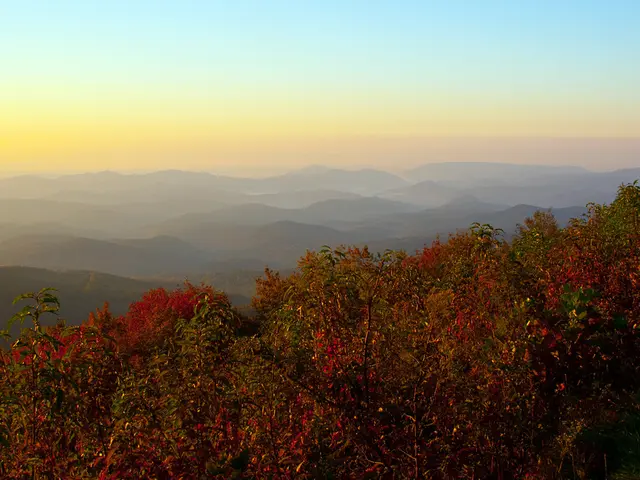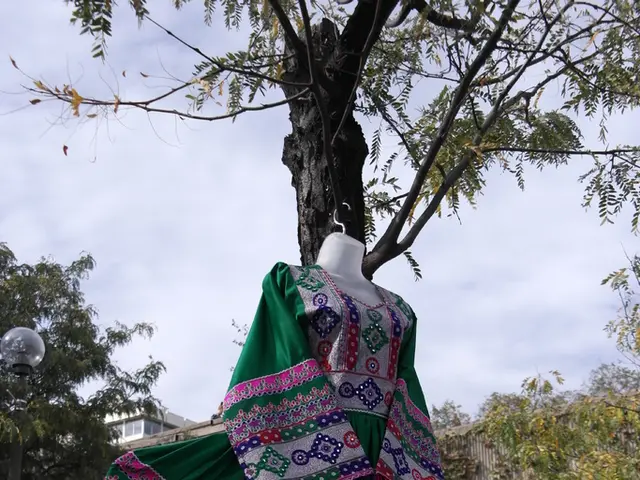Underground Metropolises Carved in Cappadocia's Land: Stone, Tuff, and Ancient Craftsmanship
Step into a world sculpted by the hands of nature and the minds of ancestors in Cappadocia - a land where dreamlike fairy chimneys pierce the sky and secrets lie buried beneath the sun-kissed hills. Here, you'll find outstanding cave cities that whisper tales of resilience, ingenuity, and survival. It's a realm that feels oddly both mythical and human, where a sketchbook brought to life by nature and necessity creates a captivating wonder. Let's venture beneath the soil and unravel the mysteries of this incredible land.
The Rocky Marvel: Tuff
The geological treasures of Cappadocia lie in the rugged terrain crafted by volcanic eruptions. The ash that settled and compressed into tuff - a soft, porous rock - forms the bedrock for the underground cities. This unique combination of strength and malleability offers a perfect canvas for human creativity. If you've ever sculpted something from wet clay, you have a taste of tuff's magical properties - strong yet yielding, a gift from the earth waiting for the sculptor's touch.
The Depths of History: Underground Cities
Thousands of years ago, the people of Cappadocia faced unrelenting hardship. In response, they delved deep and carved dwellings into the hills. Their modest shelters evolved into sprawling cities beneath the surface - Derinkuyu and Kaymakli, for instance, could house thousands during times of turmoil. It's awe-inspiring to envision a city completely concealed below the earth - bustling markets, churches, wineries, all shielded by the silence of stone.
Breathe Easy, Stay Alive: Ancient Engineering
Living underground necessitated more than just shelter; it required genius and determination. The inhabitants ingeniously engineered complex ventilation systems that resembled the veins of a living organism, delivering fresh air to every chamber. Clean water was another challenge successfully met by brilliant water systems. Today, these masterpieces of ancient engineering continue to function, demonstrating the remarkable resourcefulness of the people who lived here.
Escape Hatch: Hidden Passages and Traps
The cave cities of Cappadocia are legendary for their intricate network of narrow passageways and hidden traps. Narrow corridors force adversaries to move single file, providing defense advantages. Some rooms could be sealed off with massive stone doors that roll across narrow shafts at a moment's notice. There were even false passages designed to baffle and deter enemies. These clever defenses turned the cities into impregnable fortresses, where knowing the labyrinth could mean the difference between life and death.
The Open Sky: Above Ground
While the underworld captures the imagination, Cappadocia's surface offers breathtaking beauty as well. Towering fairy chimneys rise from the valleys, shaped by the wind and rain over time. The toughness of tuff allowed locals to carve homes, churches, and dovecotes within these natural pillars. The fairy chimneys create a surreal spectacle - a fairy tale come to life - reminding us that nature can be as bold and imaginative as human dreams.
Divine Crypts: Hidden Churches and Frescoes
As Christianity took root in Cappadocia, believers found refuge in the region's caves. They transformed underground chambers into sanctuaries, adorning the walls with vibrant frescoes depicting biblical scenes. The Göreme Open-Air Museum is a treasure trove of these churches, where faded colors and haunting faces still tell tales of faith from thousands of years ago. It's astonishing to think that faith could thrive in such secluded corners of the earth.
Daily Life Beneath the Earth
Life in the cave cities required a delicate balance of hardship and unity. Families shared resources and responsibilities, living together in interconnected rooms. There were kitchens, communal ovens, and storage facilities for grains and wine. Even animals had their own quarters - underground stables protected livestock from the harsh winter cold and predators. Through sheer will and shared efforts, the people of Cappadocia created communities that flourished in the darkest of places.
Flock Together: Pigeons and Dovecotes
One of the most unexpected features of Cappadocia is the network of dovecotes - small rooms built high in the hills for pigeons. While they initially seem like a quirky touch, these birdhouses played a vital role in agriculture. Pigeon droppings, rich in nutrients, were collected and used as fertilizer in the region's vineyards and fields. Farmers even trained pigeons to carry messages between settlements. In Cappadocia, every element, from homes to birds, was woven into a larger pattern of survival.
Protect and Conquer: Defensive Tactics
The people of Cappadocia developed a sharp defensive mindset due to constant threats and uncertainty. The cave cities had hidden entrances, disguises, and controlled communication methods. During times of danger, entire communities would disappear underground in a matter of hours, leading raiding parties to move on, leaving the hidden cities undamaged. It's an inspiring example of intelligence and resourcefulness triumphing over brute force.
Connecting the World: Trade Routes and Cultural Influences
Despite their hidden nature, the underground cities of Cappadocia were never isolated from the wider world. Located along ancient trade routes, the region served as a crossroads for traders, pilgrims, and travelers from Asia, Europe, and Africa. Booming markets sprang up above and below ground, and goods from distant lands - exotic spices, rare silks, precious metals - flowed through the valleys. This blend of cultures left its mark on Cappadocia's aesthetic, language, and traditions, fashioning it into a rich tapestry of ideas and influences.
Erosion's Artistry: Sculpting the Landscape
Wind and rain have patched together Cappadocia's otherworldly beauty over millennia. The erosion of the soft volcanic tuff created deep valleys, extraordinary rock formations, and vast plateaus. Rainwater carved caves and secret tunnels deep within the earth. Even today, the forces of nature continue this slow, relentless sculpting. Walking through the valleys, one feels dwarfed by time itself - a living testament to the power of nature's artistry.
From Obscurity to UNESCO: Reclaiming the Past
For centuries, Cappadocia's underground cities remained shrouded in secrecy, only known to the locals. It wasn't until the nineteenth century that the world began to uncover the extent of their grandeur. In 1985, UNESCO recognized the region as a World Heritage Site, attracting international fascination. Tourists, scholars, and dreamers from across the globe flock to Cappadocia today, eager to walk in the footsteps of history and touch the living stone.
Preserving History: Life in Cappadocia Today
Modern Cappadocia continues to vibrate with the energy of its ancient roots. Some caves are still used as homes, hotels, and even art studios. Traditional crafts like pottery and carpet weaving remain essential parts of the local culture, passed down through generations. Although tourism has brought prosperity, growing challenges demand careful attention - balancing preservation with progress, and ensuring that the essence of Cappadocia remains timeless.
The continued Quest for Knowledge: Scientific Discovery
Recent years have seen a surge in scientific interest in Cappadocia. Using ground-penetrating radar and 3D mapping, archaeologists seek to uncover hidden chambers and reconstruct ancient layouts. Geologists study tuff's unique properties, hoping to glean insights into sustainable building practices. Each discovery peels back another layer, deepening our understanding of this extraordinary landscape and the people who created it. The journey to uncover the secrets of Cappadocia is far from over.
Myth and Legend: Cryptic Tales and Hidden Treasures
As the years pass, legends and stories have grown around Cappadocia's cave cities. Local folklore speaks of hidden treasures, miraculous escapes, and fairy spirits that dance upon the chimneys at night. Some believe the cities are connected by secret tunnels that stretch for miles, while others whisper of ancient curses and lost civilizations. The tales of Cappadocia inject a sense of mystery and wonder, blurring the line between history and imagination.
The Struggle to Preserve a Legacy: Ecological Impact and Sustainability
The construction of the underground cities had unforeseen benefits for the environment. The insulation properties and craftsmanship preserved the natural landscape, minimizing waste and reducing the need for fuel. As tourism flourishes, however, pollution, overcrowding, and erosion pose challenges to this delicate balance. Conservation efforts are underway, working to preserve Cappadocia's heritage for future generations while promoting sustainable development.
The Allure of Darkness: Psychological Insights
Living underground isn't just a physical challenge - it's a psychological one. The darkness, isolation, and silence can be both soothing and overwhelming. Still, for centuries, the people of Cappadocia thrived beneath the ground, developing strong bonds and deep-rooted traditions. Recent research suggests that the sense of security provided by the cave cities fostered resilience and creativity in the inhabitants. It's a powerful reminder that humans can adapt to even the most unlikely environments, finding light even in the darkest corners.
Tourism and the Future: Preservation and Progress
Cappadocia's unique beauty attracts millions of visitors each year, drawn by the region's captivating caves, valleys, and vibrant towns. With such popularity comes responsibility - balancing the need to share Cappadocia's wonders with the world, while ensuring that its essence remains unchanged. Preservation efforts are underway, focusing on restoring frescoes, regulating foot traffic, and protecting fragile archaeological sites. The goal is to strike a delicate balance between preservation and progress.
Personal Reflections: Awe in the Underground
Standing in a dimly lit passageway below Cappadocia, the cold touch of stone drives home the incredible effort that went into creating the underground cities. The scent of earth and the distant echoes of footsteps stir the imagination. It's humbling to ponder the resilience and ingenuity of the people who made these incredible labyrinths their homes. Visiting Cappadocia is a journey not just through space, but through time - a chance to connect with the enduring spirit of humanity.
The mysteries of the Past: Unanswered Questions and Enduring Enigmas
Despite all we now know about Cappadocia's cave cities, countless mysteries remain. Scholars still grapple with the question of how some of the deepest tunnels were carved - especially considering the primitive tools available to the ancient inhabitants. And what secrets still lay hidden in chambers that have yet to be uncovered? Each new discovery sparks fresh inquiries and ignites the spirit of exploration. The underground cities of Cappadocia continue to offer tantalizing glimpses of ancient secrets, waiting for curious minds to unravel.
- Sustainable creativity flourishes in Cappadocia's cave cities, as the geological treasures of tuff provide a perfect canvas for human ingenuity.
- Embrace the enigma of the space beneath the sun-kissed hills, where a labyrinth of hidden cities warns intruders through narrow corridors and hidden traps.
- As scientific discoveries uncover more about Cappadocia's past, environmental-science studies focus on using the ancient techniques of the region to create a more sustainable lifestyle, blending home-and-garden designs with tuff's unique properties.
- Embark on a travel adventure to Cappadocia, where the contrast between the vibrant environmental-science creations on its surface and the dark, underground cities hint at an enduring battle with climate-change forces.






